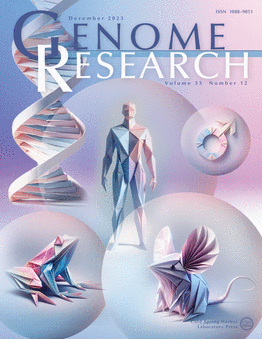绘制TP53对癌症转座因子的调控图景
IF 6.2
2区 生物学
Q1 BIOCHEMISTRY & MOLECULAR BIOLOGY
引用次数: 0
摘要
TP53与转座因子(te)之间的关系一直不清楚。鉴于TE在肿瘤发生中的重要作用,全面分析TP53调控下TE的表达动态为更清楚地了解TP53在癌症中的作用提供了宝贵的资源。在这项研究中,我们使用长读RNA-seq和短读RNA-seq在三种仅在TP53遗传状态变化的癌细胞系中表征了TE转录组学景观。为了鉴定使用te作为潜在启动子的转录本,我们开发了一个计算管道TEProf3,并以高可信度鉴定了总共1942个转录本。在这些te衍生转录本中,239个被TP53激活,221个被TP53抑制。这些响应tp53的te衍生转录本主要由ERV和LINE家族的成员驱动。在敲除野生型(WT) TP53表达后,挽救WT TP53表达可以部分恢复在慢性TP53表达背景下观察到的TE表达谱。TP53突变R175H和R273H部分通过激活TE启动子以细胞类型特异性的方式表现其致癌特性。最后,我们确定了有助于控制TEs和TP53之间相互作用的重要序列基序,其中TP53通过直接结合基序激活TEs和TP53结合基序,并通过其他途径间接抑制TEs。总的来说,我们全面分析了TP53对等基因癌细胞系TE衍生启动子活性的影响,并提供了作为TP53直接和间接靶点的TE启动子的高可信度TE表达图谱。本文章由计算机程序翻译,如有差异,请以英文原文为准。
Charting the regulatory landscape of TP53 on transposable elements in cancer
The relationship between TP53 and transposable elements (TEs) has been obscure. Given the important role of TEs in oncogenesis, a comprehensive profiling of TE expression dynamics under the regulation of TP53 provides valuable resources for more clarity in TP53's roles in cancer. In this study, we characterized the TE transcriptomic landscape using long-read RNA-seq and short-read RNA-seq in three cancer cell lines varying only in TP53 genetic status. To identify transcripts that use TEs as potential promoters, we developed a computational pipeline, TEProf3, and identified in total 1942 transcripts with high confidence. Among these TE-derived transcripts, 239 are activated by TP53 and 221 are repressed by TP53. These TP53-responsive TE-derived transcripts are mainly driven by members of the ERV and LINE families. Following knockdown of wild-type (WT) TP53 expression, rescuing WT TP53 expression allows for partial recovery of the TE expression profile observed in the context of chronic TP53 expression. TP53 mutations R175H and R273H manifest their oncogenic characteristic partially through activating TE promoters in a cell type–specific manner. Lastly, we identified important sequence motifs that help govern the interactions between TEs and TP53, where TP53 activates TEs with TP53 binding motifs through direct binding and represses TEs indirectly via other pathways. Overall, we present a comprehensive profiling of the impact of TP53 on the activity of TE-derived promoters in isogenic cancer cell lines and provide a high-confidence TE expression atlas of TE promoters that are direct and indirect targets of TP53.
求助全文
通过发布文献求助,成功后即可免费获取论文全文。
去求助
来源期刊

Genome research
生物-生化与分子生物学
CiteScore
12.40
自引率
1.40%
发文量
140
审稿时长
6 months
期刊介绍:
Launched in 1995, Genome Research is an international, continuously published, peer-reviewed journal that focuses on research that provides novel insights into the genome biology of all organisms, including advances in genomic medicine.
Among the topics considered by the journal are genome structure and function, comparative genomics, molecular evolution, genome-scale quantitative and population genetics, proteomics, epigenomics, and systems biology. The journal also features exciting gene discoveries and reports of cutting-edge computational biology and high-throughput methodologies.
New data in these areas are published as research papers, or methods and resource reports that provide novel information on technologies or tools that will be of interest to a broad readership. Complete data sets are presented electronically on the journal''s web site where appropriate. The journal also provides Reviews, Perspectives, and Insight/Outlook articles, which present commentary on the latest advances published both here and elsewhere, placing such progress in its broader biological context.
 求助内容:
求助内容: 应助结果提醒方式:
应助结果提醒方式:


